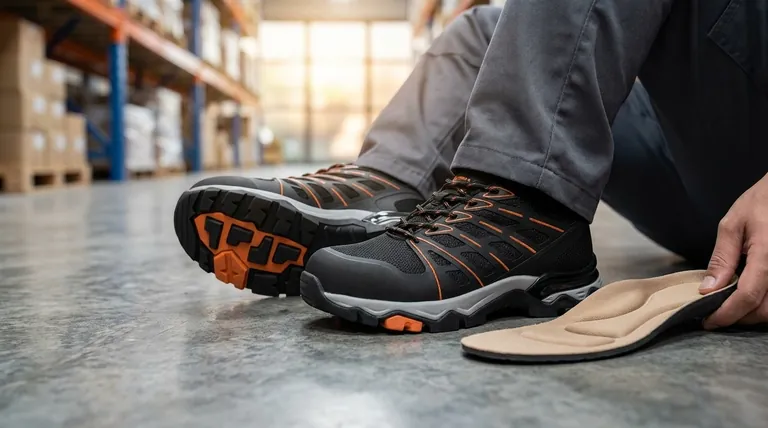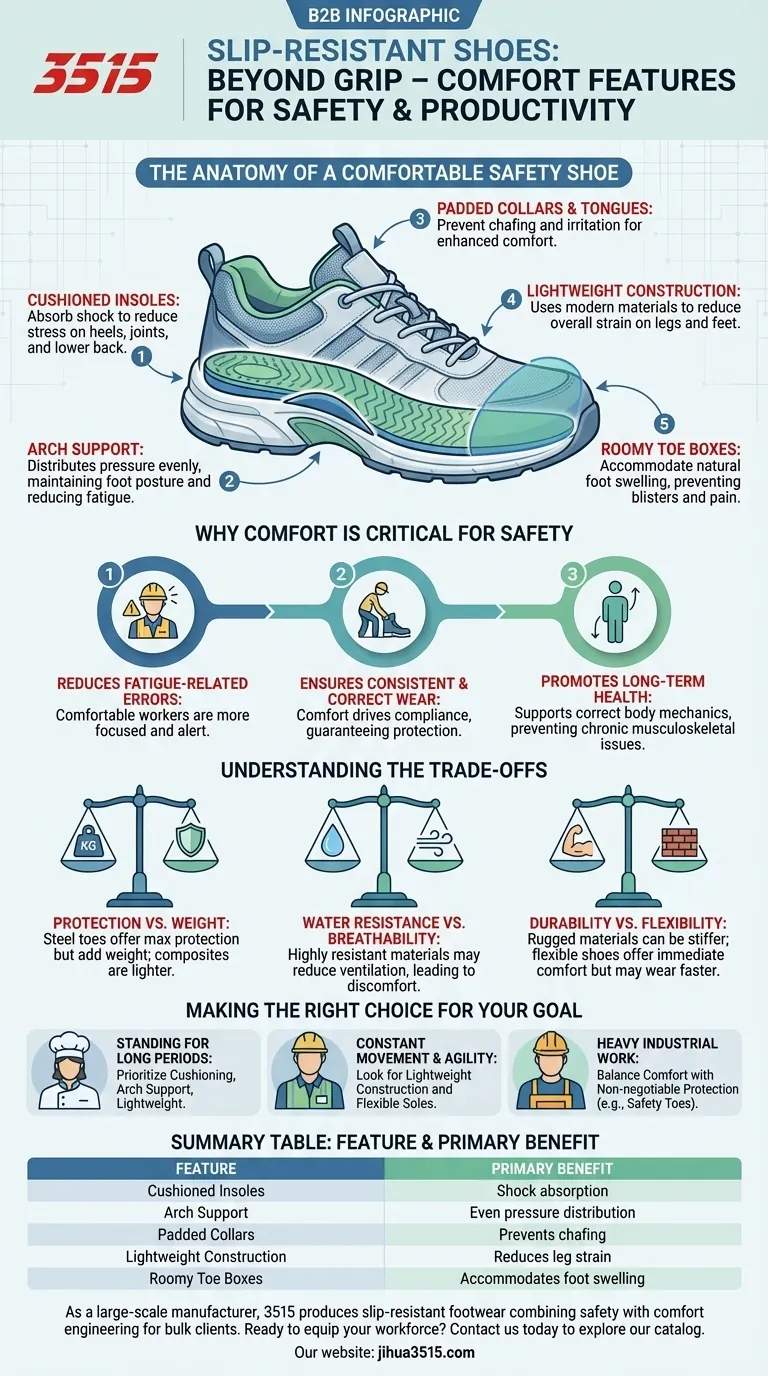To ensure all-day comfort and prevent fatigue, slip-resistant shoes are frequently engineered with features beyond just their specialized outsoles. They often include cushioned insoles for shock absorption, substantial arch support to maintain foot posture, padded collars to prevent chafing, and are constructed from lightweight materials to reduce overall strain on your legs and feet.
While a high-traction sole is the defining safety feature of a slip-resistant shoe, true effectiveness comes from combining that grip with comfort. Features that reduce fatigue are critical because they ensure the shoes are worn properly and consistently, directly contributing to worker safety and productivity.

Beyond Grip: The Anatomy of a Comfortable Safety Shoe
The design of a modern slip-resistant shoe acknowledges that safety and comfort are deeply interconnected. A worker who is comfortable is less likely to be fatigued, and a less fatigued worker is more alert and less prone to accidents.
Cushioned Insoles
The insole is the first line of defense against the impact of walking or standing on hard surfaces for hours. High-quality cushioning absorbs shock, reducing stress on your heels, joints, and lower back.
Arch Support
Proper arch support is crucial for distributing pressure evenly across your feet. This helps prevent common issues like plantar fasciitis and ensures better body alignment, which can reduce fatigue over a long shift.
Padded Collars and Tongues
The area around the ankle is sensitive to friction. Padded collars and tongues prevent rubbing and chafing, enhancing comfort and eliminating a common source of distraction and irritation.
Lightweight Construction
Heavy shoes add to the physical burden of a demanding job. Manufacturers often use modern, lightweight composite materials to reduce the shoe's overall weight without sacrificing durability or protection.
Roomy Toe Boxes
Feet naturally swell over the course of a long workday. A shoe with a roomy toe box accommodates this swelling, preventing the painful constriction that can lead to blisters, bunions, and other foot problems.
Why Comfort Is a Critical Safety Feature
Thinking of comfort as a "nice-to-have" feature is a common mistake. In demanding work environments, comfort is an essential component of the shoe's overall safety system.
Reducing Fatigue-Related Errors
Physical discomfort is a major contributor to fatigue. By minimizing foot pain and strain, a comfortable shoe helps keep workers more focused and alert, reducing the likelihood of slips, trips, and other errors.
Ensuring Consistent and Correct Wear
If safety shoes are uncomfortable, workers may loosen them, modify them, or avoid wearing them altogether, completely negating their protective benefits. Comfort drives compliance.
Promoting Long-Term Health
Properly designed shoes do more than prevent acute injuries. By supporting correct posture and body mechanics, they help prevent the chronic musculoskeletal issues that can develop from years of standing or walking on hard surfaces.
Understanding the Trade-offs
Choosing the perfect shoe always involves balancing competing priorities. It's important to understand the typical trade-offs to make an informed decision based on your specific needs.
Protection vs. Weight
Features like steel toes or metatarsal guards offer maximum protection but add significant weight. Composite safety toes are a lighter alternative but may not be suitable for all industrial environments.
Water Resistance vs. Breathability
Materials that offer excellent water or chemical resistance are often less breathable. This can lead to sweaty, uncomfortable feet, so you must weigh the need for protection from liquids against the need for ventilation.
Durability vs. Flexibility
Extremely durable sole materials and rugged uppers may be stiffer and require a longer break-in period. More flexible shoes might offer immediate comfort but may not withstand the same level of abrasion over time.
Making the Right Choice for Your Goal
Your specific job function should dictate which comfort and safety features you prioritize.
- If your primary focus is standing for long periods (e.g., food service, healthcare): Prioritize superior cushioning, strong arch support, and a lightweight design to minimize fatigue.
- If your primary focus is constant movement and agility (e.g., warehouse, delivery): Look for a shoe that combines lightweight construction with a flexible sole for an easy, natural stride.
- If your primary focus is heavy industrial work (e.g., construction, manufacturing): Balance comfort features with non-negotiable protection like certified safety toes and oil- and chemical-resistant materials.
Ultimately, selecting the right slip-resistant shoe is an investment in both your immediate safety and your long-term well-being.
Summary Table:
| Feature | Primary Benefit |
|---|---|
| Cushioned Insoles | Shock absorption for heels and joints |
| Arch Support | Even pressure distribution, reduces fatigue |
| Padded Collars | Prevents chafing and irritation around the ankle |
| Lightweight Construction | Reduces leg and foot strain |
| Roomy Toe Boxes | Accommodates natural foot swelling |
As a large-scale manufacturer, 3515 produces a comprehensive range of slip-resistant footwear for distributors, brand owners, and bulk clients. Our production capabilities ensure that every pair combines critical safety features with superior comfort engineering—like cushioned insoles and arch support—to keep workers safe, productive, and comfortable throughout their shift.
Ready to equip your workforce with the right balance of safety and comfort? Contact us today to discuss your specific needs and explore our full catalog of durable, comfortable safety shoes and boots.
Visual Guide

Related Products
- Premium KPU Injection Athletic Style Safety Shoes
- Wholesale Anti-Smash & Puncture-Proof Safety Shoes Custom Manufacturing for Brands
- Custom Wholesale Leather Safety Boots Direct Factory Manufacturing
- Customizable Anti-Smash Safety Boots for Wholesale & Private Label Manufacturing
- Heavy-Duty Waterproof Nubuck Safety Boots Safety Shoes for Bulk Supply
People Also Ask
- Does allowing employees to wear steel-toe rubber boots offsite exempt the employer from payment? Understand OSHA's specialty PPE rules.
- What safety standards should oilfield work boots meet? Ensure OSHA & ASTM F2413 Compliance
- Why is safety the top priority when selecting oilfield work boots? Essential Protection for High-Risk Environments
- Why is expert help recommended when selecting safety shoes? Ensure Perfect Fit & Hazard Protection
- What is the ASTM standard for puncture resistance? A Guide to Selecting the Right Protective Footwear



















